The swarm we collected on Thursday, and housed in a new hive in the orchard, so far seems to be doing very well.
On Sunday afternoon, as the weather was warm and beautiful outside, we decided to conduct a brief cursory inspection of the hive. As new beekeepers it’s important to curb the temptation to peek inside the hive too often, but to best judge how the bees are doing, and whether or not we are meeting their needs, we needed some baseline information about the hive.
A wise beekeeper recently told us that when you do a hive inspection, first ask yourself why you are doing it? What do you hope to learn? There are many reasons to inspect a hive, but “just because I want to look” isn’t one of them.
Our first inspection we hoped to gather three primary pieces of information. First and foremost, how large is this colony of bees? The swarm looked sizable, but we weren’t sure if the current hive configuration was appropriate for the number of bees. If we only had a few frames of bees, it might be best to reduce the size of the hive until their numbers increase. Two other questions we hoped to answer were, can we find the Queen, and if so, is the Queen laying eggs yet?
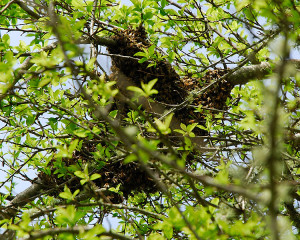
As a swarm, it looked to us like a lot of bees, about the size of a soccer ball, but we weren't really sure how to quantify them at the time
The last we interacted closely with the bees they were still in swarm-mode, and very docile. This would be the first time we’d be entering their new home, and their disposition, now they are no longer clustered as a swarm, could potentially be more aggressive.
As we have protective clothing, and this was just an inspection, we felt using a smoker was unnecessary. We suited up, and gathered some basic equipment, a manipulation cloth and an extra couple of dish towels, a bee brush, and our hive tool, and set off for the hive.
When we arrived we began by simply observing the hive entrance. How many bees are there? Are there bees carrying pollen into the hive? Are there ants, or other intruders lurking at the hive entrance?
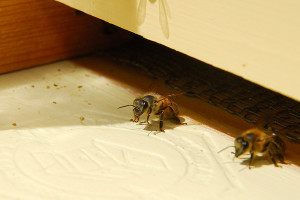
We passively observed the comings and goings at the hive entrance for a few minutes before entering the hive
We then proceeded calmly and quietly toward the hive, and carefully removed the top. The hive is currently comprised of two medium 8-frame hive bodies.
As we removed the roof, we were quite surprised to see a substantial cluster of bees just underneath the hole in the inner cover.
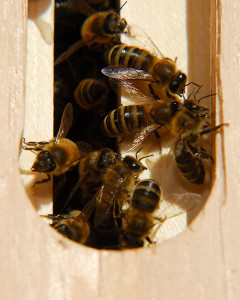
The inner cover has an oval hole in the center, and we could clearly see a number of bees on the frames underneath
Next, we removed the inner cover. We were careful to place the cover on its edge when we set it down, as there were a few bees underneath the inner cover when we lifted it from the hive.
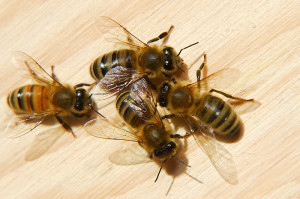
It's important to be aware of where bees are as you move equipment around, so you don't accidentally crush them
With the cover removed we could see that there were four frames crowded with bees in the upper hive body. We carefully removed one of the empty frames from one end so we had a little more room to work.
As we slid the frames apart we noted the bees connected together in chains between the frames. Bees can commonly be seen doing this during comb building, and the chaining together is known as a Festoon. There are many theories about this behavior, but it seems nobody really knows for certain why the bees do it. [1]
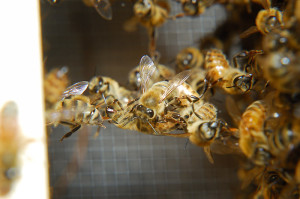
As we slowly moved the frames, small chains of bees could be observed stretching from one frame to the next
We removed one of the frames with the bees, being very careful to ensure we kept the frame over the top of the hive while inspecting it. The most important task during an inspection is to avoid dropping or losing the Queen! It’s better that if she falls from the frame, that she falls into the hive below, and not onto the ground!
We were surprised to see that the very first frame we pulled not only had drawn comb, but also already had nectar stored. We had fitted the frames with foundation, but the bees were working very quickly to build comb on the foundation to store the food they will need while they build out the rest of their new home, and begin to raise new bees.
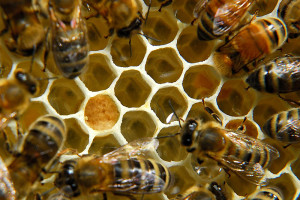
As the bees moved out of the way we could clearly see they had already drawn out comb on some of the foundation
As we wanted to keep the disruption to a minimum, we replaced that frame, and removed the top box, setting it carefully on the inverted lid of the hive, again, to minimize the risk of misplacing her Royal Highness. We then covered the top of that hive body with a cloth to keep the bees calm while we turned our attention toward the other hive body.
As we removed the upper hive body it was clear there were at least as many bees in the bottom hive body.
Here we were most interested to see how the two old frames that had drawn comb looked. The trouble was, it was difficult to see through the bees as they were elbow to elbow across the entire frame.
We’d hoped to have a better view into the cells on these two older frames, as we were curious to see if there might be any signs of eggs in some of the cells.
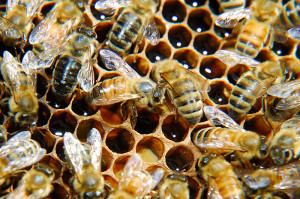
We didn't see any eggs, but there was plenty of stored nectar, and some occasional pollen. We also noted a few drones (males) on some of the frames.
As we didn’t inspect every frame during this inspection, we failed to see the Queen. We didn’t necessarily expect to see eggs so soon. As it takes three days for an egg to become a larva, we knew we would not see any larva during this inspection as it’s too early. We’ll make more of an effort to observe eggs and/or larva during our next hive inspection though.
What we did learn from this inspection is that we had more than 8 frames of very good natured bees in the hive. It was the middle of the day, so not everyone was home, as there were also lots of workers in the field. To us this seems like a perfectly respectably-sized colony of bees.
Needless to say the girls, in just 72 hours, have been much busier little bees than we expected. We’re looking forward to our next hive inspection, and curious how different the hive will look the next time we peek inside.
————————–
[1] Tautz, Jurgen and Heilmann, Helga. 2008. The Buzz About Bees: Biology of a Superorganism. p 167.


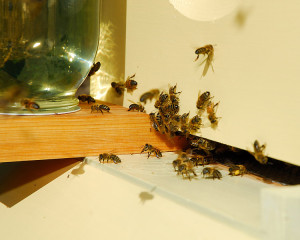

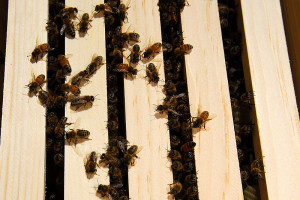

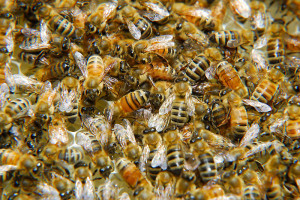
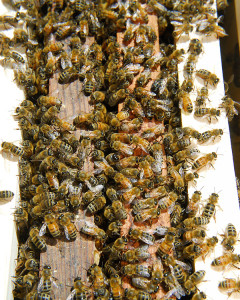

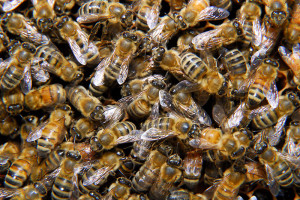

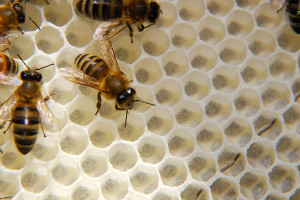
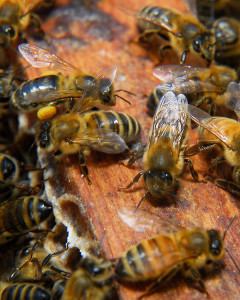
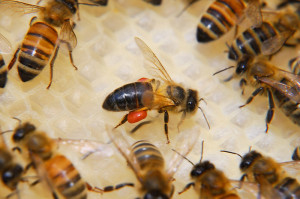







I found your blog while looking for information on pullet eggs, and I am TRANSFIXED!! Your bees are amazing!!!! I can’t wait until the next inspecition!
Thanks for stopping by Stacey! Glad you’re enjoying the blog! 🙂
Great photos. I’m not sure if I will be getting ‘suited up’ and taking my camera with me anytime soon though. Looks like the swarm bees have been busy! The newly drawn comb is so delicate looking. They are amazing creatures, to say the least.
I ordered my hive and bees today, so I’m starting to get excited. My wife and I talked beez at lunch. I think she is just happy we’re not getting chickens! (yet)
Glad to hear you’ve ordered your bees! I find it slightly amusing that your wife would rather have bees than chickens. I think it’s fun to have both 😛
Fabulous photos! Thrilling to see how busy they have been in so short a time. Must bee happy in their new home.
They certainly look happy, I can’t believe how quickly they’ve settled in!
Utterly fascinating. Quite impressive to see all that new comb appear so quickly.
Thank you for so thoroughly chronicling your new neighbors.
Well, it does seem I won’t run out of blog post topics for a while 😉 I was very surprised at how much comb was not only drawn out, but that they were already using for stores. They get more done in 10 minutes than I do in a week! 😀
Great news that they are making themselves right at home! Now that you have Fowl Friday will we get weekly bee updates?
We certainly plan some regular bee updates. May not quite be weekly though, as we won’t inspect the hive that frequently. We will probably peek this weekend, IF the weather is nice enough (supposed to have more rain later this week), just to confirm that we have eggs being laid in the comb. We will update after inspections though, especially while we’re learning what it is we’re actually looking at in there! 😉
Looks like you did it! What a great job on catching your first swarm and starting a new hive. I hope to get my hive tomorrow while it is raining and in several weeks I’ll get my bees. Looking forward to more updates!
We are a little bit proud of ourselves for managing to get all of our ducks in a row, and successfully get these bees settled in a new home. It won’t be long before your new hives will be buzzing too!
This is ridiculously fascinating to me. I would love to see something like this in person.
It’s ridiculously fascinating to me too. As if there weren’t enough distractions in the garden, birds, cool bugs, little wildflowers, and an ocean of weeds, now I find myself just standing in the garden staring at the front of the hive for minutes on end. They really are amazing, and industrious creatures.
A thrilling read, Clare, from the inception of gathering your feral swarm and seeing them adjusting to the hive. You and Mr CV are such professionals and would take my beekeeper’s hat off to you if I had the courage to keep these fascinating insects myself.
Laura
Although I know beekeeping isn’t for everyone, these bees at least seem to be quite placid, and it’s been so exciting to work with them. If you ever have a chance to suit up and steal a peek inside someone’s hive, I highly recommend it!
Congratulations! I will be following along with you all summer!
Looking good! The new comb is beautiful! Live that red pollen.
We use our smoker to “herd” the bees, not merely fir calming them down.
Our mentor always forgets to smoke his bees, so I hadn’t really appreciated that we could just use it to herd the bees. That actually might have helped, although we only intended this first peek to be a quickie inspection. Maybe next time though we’ll take the smoker just in case. Bees are difficult to see through 😛
Uh, I “love” that red pollen.
I agree, that’s a fantastic color on that last worker. It makes me want to know where she found it!
A fascinating read from start to finish, Clare. I’m sure I’m going to enjoy your journey into beekeeping! 🙂
Glad to see you around Meredith, thanks for stopping by! I hope your spring garden is bursting forth with blooms! I miss your posts 🙁
I feel like I am reading an exciting novel published in installments and can’t wait for the next section. Congratulations on the successful transfer of the bees to your hive.
Fantastic! You are demonstrating how rich life can be by connecting to the environment in such an intimate way. Growing your own food, raising your own fowl, and now bee keeping – your life is full of rewarding experiences. Thank you for sharing a portion with us so that we may enjoy it vicariously. You are an inspiration!
Absolutely fabulous! Glad you were able to take photos in the short time you wanted to spend looking. Looks like they like the hive so far and I’m going to scare up that Peanut butter and honey cookie recipe for you.
Congratulations on your apparent success!
Fascinating, Clare. I was wondering if, since you have so many bees in the hive, you will add more frames.
(My mother always said “You can learn something new every day if you go to the right place to learn it,” and your blog is clearly one of those right places!) -Jean
We will Jean, although not yet. The inspection we just did this weekend showed there was still room, but we did have to rearrange a few frames to encourage the bees to make the best use of the space. I expect by the next inspection we may need to add another hive body (containing 8 new frames). There’s a lot of nectar and pollen coming in at the moment!